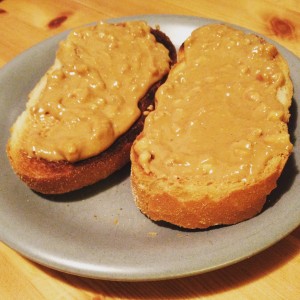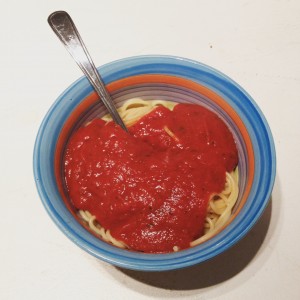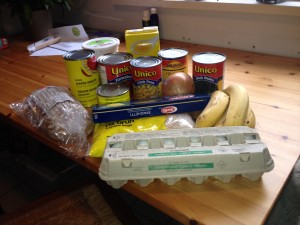Today I am thinking about poverty and social isolation. As I sit here, thinking about the week so far, my mind wanders to the first day of the challenge. When I shopped for my $21 of food, I was in the grocery store for quite some time. Even though I was the only person who knew I had a limited amount of money with which to buy food, I felt weird, out of place. I felt embarrassed. I felt awkward. People came and went in the aisles of the grocery store, grabbing packages here and there without much hesitation, and there I stood, meticulously rifling through each and every bag of pasta or rice, figuring out which would be the most frugally responsible purchase but still give me adequate energy and nutrition. I wandered through the bread aisle, back and forth, deciding which would be the best purchase. I came across the sale shelf. 50% off for a loaf of old bread. It was a nice, dense looking rye bread. I knew I wouldn’t be able to afford this bread at regular price, so I grabbed it off the shelf. I was going to have to be careful to freeze it quickly so it wouldn’t go mouldy. What if I didn’t have a fridge? Which bread would be the best to buy? When Kaleigh went to get her groceries later, the discount rye bread was gone. She had to settle for 50% white french bread.
I knew I wanted some vegetables, so I wandered the aisles looking for any that might be on sale. I found an old pack of mushrooms that were 50% off, just starting to slime. I knew I could sauté them with the onion I bought and they would be fine. What if I didn’t know that? What if I didn’t have a stove top or a frying pan? The onion and mushrooms would have to be the only vegetables, everything else was just too expensive. I moved on to fruit. Bananas are a cheap, filling and nutrient dense fruit, so I decided to buy a few.
When I arrived at the till and the cashier rang through each item, I stared at the computer, watching the price add up. Quickly, the price was halfway there, then almost there. Then it reached $21, then it went past. I was at $23.78. I would have to put some things back. Imagine that, standing at a till in the grocery store, a line up behind you, having to quickly decide what food to return because you can’t afford to buy it all, to buy the absolute bare minimum. I thought quickly because I didn’t want to make the people behind me wait. I decided on the milk. Nutritious? Yes. High in calories? Not as much. It wouldn’t be as filling, so it had to go. Looking around quickly I decided to put back some of the bananas, since I had 6. I decided on 4, since I knew I wanted some fruit on the days I have school. I was finally back down to $21. I quickly packed up my food and left, hoping that people weren’t too frustrated that they had to wait. What if that was my life everyday? What if I didn’t have a warm house to go home to, and money to spend on hygiene products or new clothes? Would that experience have been more embarrassing? Probably. Is food poverty socially isolating? I think so.
Being hungry and living in poverty must be very socially isolating. It’s the weekend but I have no spending money, no energy, and I am in no mood to face the outside world. My stomach hasn’t been full for five days, and it’s exhausting and depressing. I miss being full. Even if there were social situations I could attend that didn’t cost money, would I want to go on an empty stomach? What if I had experiences like the one at the grocery store on a daily basis? Would I slowly stop reaching out to people? Would I want to stay inside? $21 per week gives me money for food, but what about activities that are good for my mental health? That make me happy? Social isolation and mental health are so intimately intertwined, and hunger hangs over them both, exacerbating the feelings of depression, anxiety and apathy, which present social barriers and lead to isolation. There is evidence that social integration can improve mental health status and even decrease mortality risks. If $610 per month is so little that a person cannot eat properly, feels apathetic, and in the longterm becomes socially isolated, is this not a significant health and safety risk? Do we care? We should. We absolutely must.
Today I had plain oats and yogurt again for breakfast. My last banana is getting quite ripe and I can’t stop staring at it. I’m determined to save it for Monday though, I have a long day of meetings and class to get though, so I’m saving it for then. Today I was hungry almost immediately after breakfast, which was very challenging, since today I am doing school work. My mind wanders every few minutes, and often I get distracted by the growling of my stomach or pangs of hunger. I was able to wait until 1:30pm to have eggs and toast and hot water. Dinner tonight was the last of the fish and rice. We didn’t cook the rice in brith because we’re saving it for tomorrow. Later we will eat another scoop of Kaleigh’s peanut butter, which is something to look forward to. It’s already half gone so we’re going to have to be careful these next few days. For me, I have two more days left of this diet. For 4% of people living in British Columbia, this is life everyday. Let’s change that. Let’s Raise the Rates of Welfare in B.C.
Want to sign the petition to ask Christy Clark to raise welfare rates in B.C.? Click here: https://www.change.org/p/christy-clark-raise-social-assistance-rates-in-bc
Visit http://raisetherates.org and http://welfarefoodchallenge.org to read more about Welfare Rates in B.C. and the Welfare Food Challenge.
As always, share my blog and post on social media about this issue. It’s a big one, but we can make change.










